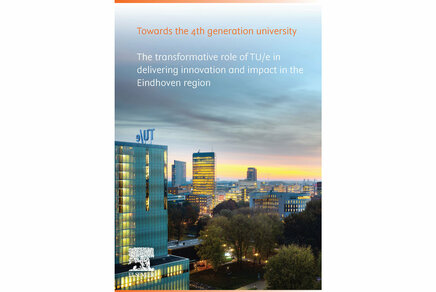The forgotten women in the natural sciences
Book brings women in natural sciences to center stage

You wouldn't think it from reading the history books, but over the centuries women have played an important role in the natural sciences. Often not officially allowed to work at a university, they sometimes published under a male pseudonym or had to watch as their male colleagues walked away with their results, or even in some cases the Nobel Prize. But all the while, they were making discoveries that to this day contribute to the building blocks of the natural sciences. To bring to center stage the women who were kept in the wings, endowed TU/e professor of science communication Margriet van der Heijden wrote the book Ongekend.
When Van der Heijden started studying physics in 1982 it wasn't long before she was the only girl in her year. There wasn't a single female student in the year groups above and below her. “And all the teachers and supervisors were men,” tells Van der Heijden, who for the past year has been an endowed professor at the Department of Applied Physics and Science Education. “Physics, math, chemistry, they were all regarded as subjects for men. This often promted the challenge: name one woman who's made an important discovery.
Van der Heijden went in search of women who had achieved something significant in physics. Along the way she discovered many more women than she had been expecting. A number of them are now included in Ongekend, her book published last week. “Actually, I could easily have produced a much longer collection.”
So women certainly have a history of being involved in the natural sciences. Why then don't we know about them? “Time and again you see women being forced into restrictive roles as subservient and caring individuals by society, roles they often internalize,” says Van der Heijden. In their youth women were trained for a life spent caring for others, says Van der Heijden. “When women were allowed to take part in academic life, they had to overcome all these prejudices.” It was also easy for men – whether intentionally or not – to take all the credit for joint discoveries. “In a highly competitive environment colleagues whose work you can easily claim as your own make tempting prey.”
Matilda effect
Another factor that touches on this is the Matilda effect, which the endowed professor describes in her book. “Then there's the Matthew effect. Someone who wins an award or grant has a greater chance of doing so again. It's generally something that happens to men not women. The Matilda effect is the reverse of this. Women's achievements are persistently underestimated. There will be comments like: Either she had a good supervisor, or apart from this she hasn't published anything.”
An example cited in Ongekend relates to Ben Barres, a scientist who transitioned from a woman to a man. When Barres gave a presentation as a man, someone said that he had given a fantastic presentation, and that his work was better than his ‘sister's’. “That says it all.”
During the French Revolution, human rights meant the rights of men
Margriet van der Heijden
Endowed TU/e professor of science communication
Times have changed, especially because access to birth control now allows women to make other decisions, says Van der Heijden. Today there are more women in science, and together they have more power to wield. But the creation of an equal playing field for men and women in science hasn't all be steady progress, she knows.
In her book, she goes back as far as the beginning of the18th century, when as the first female professor in Europe, Laura Bassi had to receive her students and colleagues at home because she was allowed to enter the university buildings only in exceptional circumstances. Bassi was a member of the Bolognese Academy of Sciences, a select group that would later permit women such as Émilie Du Châtelet and Maria Gaëtana Agnesi to join its ranks. “This was the first time in history that women managed to gain a foothold in the ‘modern’ university.”
Promising start
In view of the obstacles, this would seem be a promising start for women in the natural sciences. However, all the progress was undone when the French Revolution came along. “During the revolution, human rights meant the rights of men. Women wrote pamphlets, but weren't heard. Napoleon denied women access to universities again in Bologna.
The library where Bassi's work was held was burned to the ground.” Van der Heijden's message is that a period of progress doesn't herald the end of the struggle, even now. “Not that the progress made can ever be fully undone. There are now so many women in science and we've changed how we think about them so radically that we can rule out a complete return to the past.”
Important discoveries
Clearly, it was not easy for women to carve out positions for themselves in the natural sciences. But they were certainly there and were making important discoveries. There was Henrietta Leavitt, for example, working as a calculator at Harvard but allowed only to do routine work, while in her leisure hours she was developing a method later used by Hubble when he demonstrated the expansion of the universe.
And June Almeida, a bus driver's daughter, who took a roundabout route to gain her doctorate and become the first person to visualize the first human coronavirus. They were resilient pioneers, says Van der Heijden. She also admires Mary Anning, whose formal education ended with primary school but who nevertheless ended up corresponding with the most famous paleontologists of her time.
Not just singing praise
Yet the purpose of her book is not to sing anyone's praises, she says emphatically. “I didn't want to write a book filled only with heroines. It also includes a portrait of Harriet Brooks, for example, who stopped when she got married. And of Grace Chisholm Young, who was quite happy for joint writings to be published only under her husband's name.
I wanted to show the diversity of choices women make.” Above all, she wants to debunk the notion that there were no women in the natural sciences, and to paint a more realistic picture of history. “To say: see, they certainly were there.”
Het laatste nieuws




